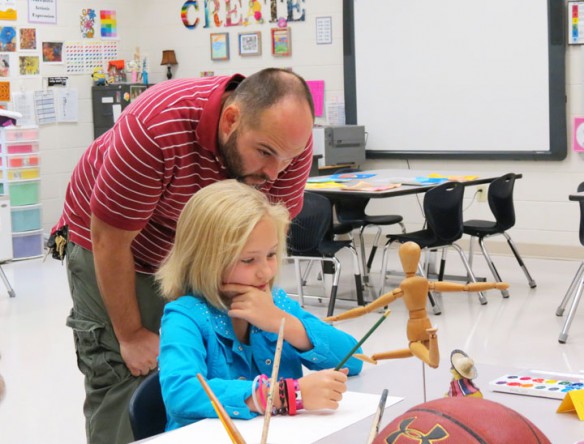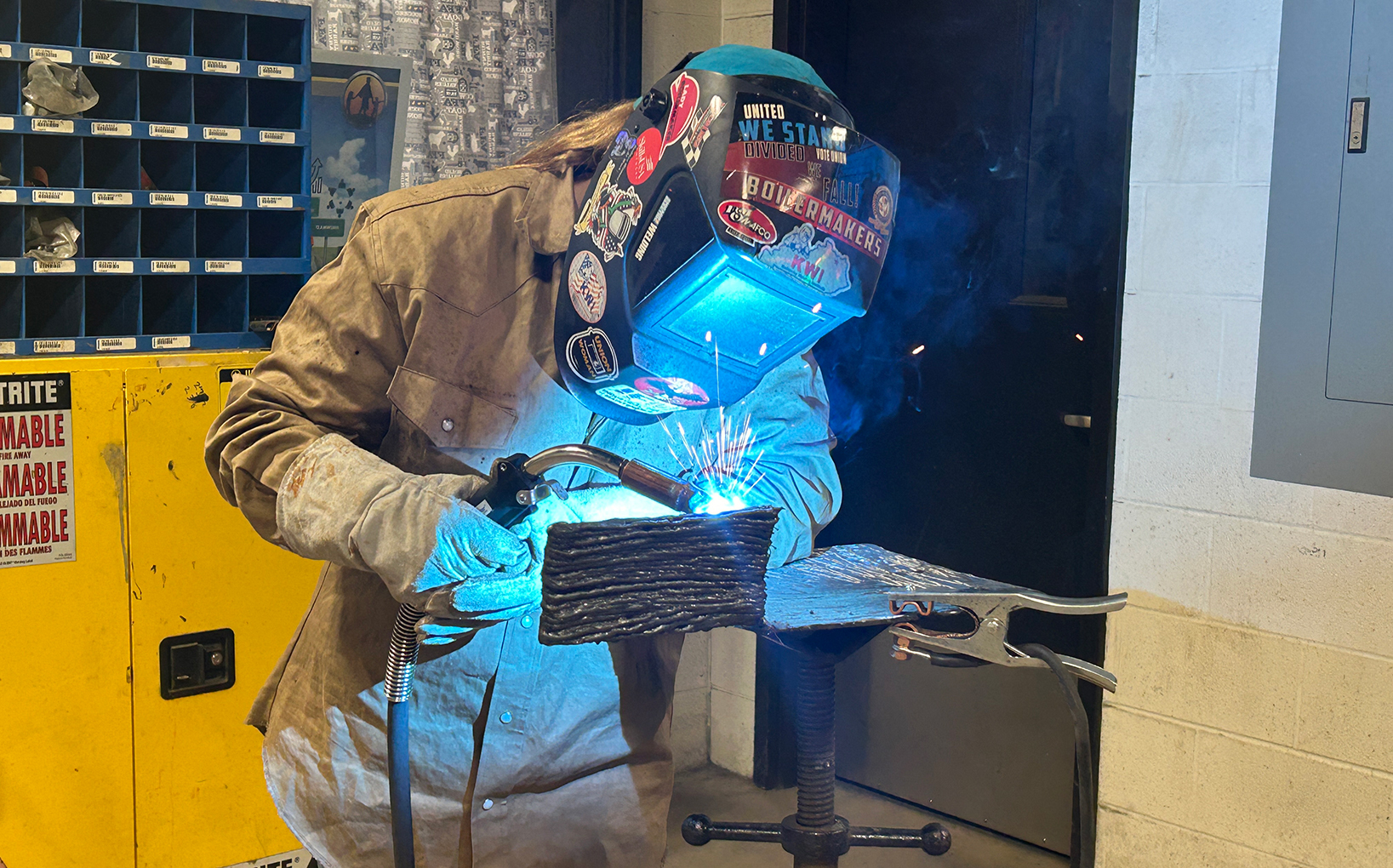
Bullitt East High School (Bullitt County) art teacher Jason Kelty helps a student during a Saturday enrichment camp.
Photo by John Roberts/Bullitt County Public Schools
By Susan Riddell
susan.riddell@education.ky.gov
Gifted education stakeholders have a firm belief that all gifted and talented (GT) students and teachers need to be given the instruction and resources needed for optimum achievement.
Toddie Adams, director of Gifted Services for the Marshall County school district, says for this to happen, GT programs need to continuously evolve to meet the growing needs of Kentucky’s brightest students and those who teach them.
“GT teachers must be effective in the classroom providing differentiated instruction for their students,” Adams said. “GT students must be engaged and challenged every day in order to prepare them for higher education and careers. A stagnant classroom or program that is not continually revising its curriculum and instruction may be overlooking the most recent evidence to better meet the unique needs of our students.”
The Kentucky Department of Education (KDE) works with state districts to make sure that gifted programs don’t become stagnant. It offers resources and trainings for instructors and helps with technical assistance for districts that use Infinite Campus to document progress.
Recently, KDE staff members led a Lync webinar regarding the Gifted Student Service Plan (GSSP) form that is available in Career Cruising’s Individual Learning Plan.
The GSSP is an individualized plan for identified gifted students in grades 4-12 designed to match student interests, needs and abilities to differentiated service options. It serves as the communication tool between parents and school personnel.
“Districts may use this tool or may create one of their own,” KDE gifted education consultant Kathie Anderson said.
KDE also works with the State Council for Gifted and Talented Education to help with district support, according to gifted consultant Denise Bailey.
“Through our work with the advisory council, we are drafting a middle school document that will describe best practices for differentiating instruction for middle school gifted students,” Bailey said. “The document will also list GT opportunities for students.”
Anderson said that KDE also is drafting an assessment document to help districts in identifying gifted students including twice-exceptional students, who are both gifted and have an identified disability.
“Our county has several twice-exceptional identified students,” said Sarah Coomer, GT coordinator for Bullitt County school district. “We make appropriate accommodations through our lesson plans to address their needs. There is not a specific GT program for these students, but they participate in an inclusion model through the cluster-grouped classes, pullout resource classes and academic camps.”
Other gifted and talented education projects are in the works, Bailey said, but it’s also critical that districts look for ways to revamp GT instruction in ways that will really enhance learning on an individual level.
“There are several districts out there providing excellent services for districts,” Anderson said.
In Bullitt County Schools, the Bullitt Academy of Math and Science (BAMS) was created in the 2010-11 school year as a highly selective program where students complete their honors mathematics and science coursework in two years, leaving their final two years for college-level classes.
Coomer said that students can end up with approximately 60 hours of college credit by the time they graduate high school. Recently, this program was recognized as a Model Service Delivery Option Site by the Kentucky Association for Gifted Education (KAGE).
This year, the district has added several initiatives to better service its GT students and teachers.
A weeklong academic enrichment camp for 4th and 5th graders puts gifted students in their future middle school for intense science and social studies units led by their elementary school gifted resource specialist.
Additionally, “the district passed a new cluster grouping policy where identified elementary and middle school students will be placed in cluster groups to focus more intensely on the needs of GT students and for teachers to provide more adequate services,” Coomer said.
Saturday enrichments are available for elementary students with themes in mathematics and science; creativity and performing arts; technology and robotics; and literature and writing. Coomer said the district hopes to expand this opportunity to middle school students in the future.
An online referral process was created to make the documentation process easier for teachers and the district’s website was updated to better communicate with parents regarding gifted and talented services.
Like Bullitt County Schools, Marshall County Schools has made many changes to its GT program this year. It also has focused efforts on helping teachers fulfill their needs.
“This year, we’ve extended our professional development opportunities during district PD days and the Marshall County KAGE,” Adams said. Among those are seminars about the Gatton Academy, differentiation for all levels of learners and working with gifted children who are considered super sensitive and over excitable.
Additionally, the district has added counseling services for gifted learners.
“With collaboration between the GT coordinators and school guidance counselors and communication with parents and students, we are identifying stress triggers in the school setting to provide coping skills for our gifted learners,” Adams said.
Adams added that revisions to procedures in the gifted and talented program have created more transparency and accountability.
“With revisions to our identification procedures, services, documentation/filing system and communication, we have evolved into a program that attempts to grow our gifted learners in their area(s) of strengths while supporting and nurturing any areas of deficiencies,” Adams said. “We continually communicate with students, parents, educators and administrators to ensure all are aware of the nature and needs of gifted children, and how we are striving to meet those needs.”
MORE INFO …
Kathie Anderson, kathie.anderson@education.ky.gov, (502) 564-4970
Denise Bailey, denise.bailey@education.ky.gov, (502) 564-4970
Toddie Adams, tatiana.adams@marshall.kyschools.us, (270) 527-0796
Sarah Coomer, sarah.coomer@bullitt.kyschools.us, (502) 869-5155
Kentucky Association for Gifted Education







Leave A Comment